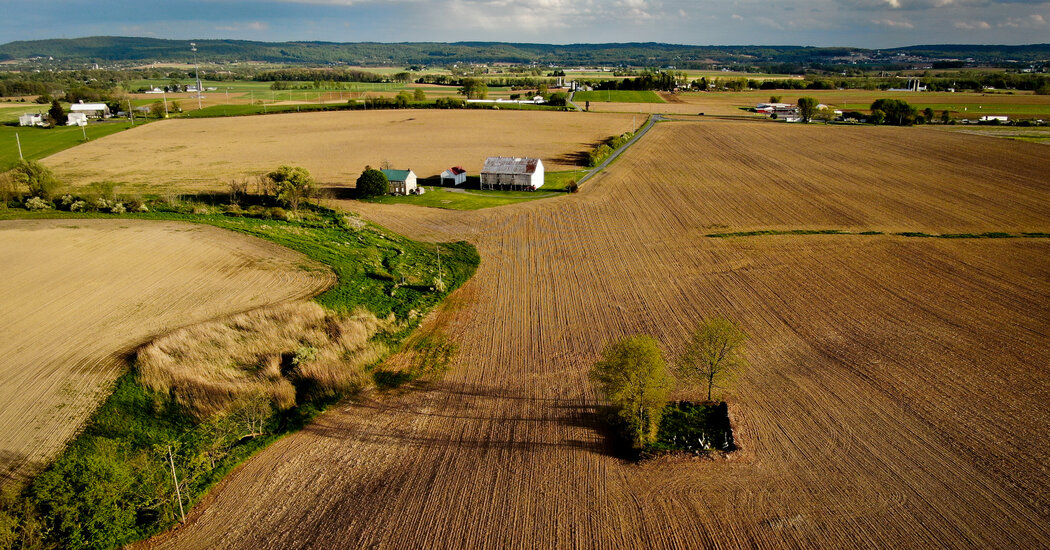ECONOMIC NEWS
A New Crop in Pennsylvania: Warehouses
OREFIELD, Pa. — From his office in an old barn on a turkey farm, David Jaindl watches a towering flat-screen TV with video feeds from the hatchery to the processing room, where the birds are butchered. Mr. Jaindl is a third-generation farmer in Pennsylvania’s Lehigh Valley. His turkeys are sold at Whole Foods and served at the White House on Thanksgiving.But there is more to Mr. Jaindl’s business than turkeys. For decades, he has been involved in developing land into offices, medical facilities and subdivisions, as the area in and around the Lehigh Valley has evolved from its agricultural and manufacturing roots to also become a health care and higher education hub.Now Mr. Jaindl is taking part in a new shift. Huge warehouses are sprouting up like mushrooms along local highways, on country roads and in farm fields. The boom is being driven, in large part, by the astonishing growth of Amazon and other e-commerce retailers and the area’s proximity to New York City, the nation’s largest concentration of online shoppers, roughly 80 miles away.“They are certainly good for our area,” said Mr. Jaindl, who is developing land for several new warehouses. “They add a nice tax base and good employment.”But the warehouses are being built at such a dizzying pace that many residents worry the area’s landscape, quality of life and long-term economic well-being are at risk. E-commerce is fueling job growth, but the work is physically taxing, does not pay as well as manufacturing and could eventually be phased out by automation. Yet the warehouses are leaving a permanent mark. There are proposals to widen local roads to accommodate the thousands of additional trucks ferrying goods from the hulking structures.In the township of Maxatawny, Pa., just west of the Lehigh Valley, a giant warehouse is slated to be built at the site of a 259-year-old cemetery that holds the remains of a Revolutionary War captain and what is believed to be the unmarked grave of a woman he had enslaved.Not far away, near a group of Mennonite farms, a tractor-trailer hit a horse-drawn buggy in late March, flipping it and sending one passenger to the hospital and the horse on the loose.Closer to Allentown, the area’s largest city, FedEx has built a new “ground hub,” one of its largest such facilities in the United States. A billboard down the road advertises legal representation for people injured in truck accidents.“They are coming here and putting up shiny new warehouses and erasing pieces of history,” said Juli Winkler, whose ancestors are buried in the Maxatawny cemetery. “Who knows if these big buildings will even be useful in 50 years.”Developers are very confident in the industry’s growth, however, particularly after the pandemic. Big warehouse companies like Prologis and Duke Realty are investing billions in local properties. Many of the warehouses are being built before tenants have signed up, making some wonder whether there is a bubble and if some of these giant buildings will ever be filled.“People are calling it warehouse fatigue,” said Dr. Christopher R. Amato, a member of the regional planning commission. “It feels like we are just being inundated.”There are now almost as many warehouse and transportation jobs in the region as manufacturing positions. But that’s not a milestone all celebrate — not in an area that hopes to keep alive its higher-paying manufacturing sector, even though some of its biggest employers like Bethlehem Steel closed long ago.Manufacturing jobs in the Lehigh Valley pay, on average, $71,400 a year, compared with $46,700 working in a warehouse or driving a truck. The region is still home to large manufacturing plants that produce Crayola crayons and marshmallow Peeps candies.Don Cunningham, the chief executive of the Lehigh Valley Economic Development Corporation, says the warehouse jobs are lifting employment and wages, particularly for unskilled workers.“If you were to turn away this economic opportunity for a whole sector of workers, where do they go?” Mr. Cunningham said. “They could end up on some sort of government assistance or end up caught up in the criminal justice system.”Mr. Cunningham, whose father worked in the local steel industry, said he recognized that distribution jobs were not ideal.“But to be able to make $16 an hour with a high school diploma, there aren’t a lot of places in the U.S. where you can do that,” he said. “This is a really nice sector for low-skilled workers. It at least gives them a fighting chance to carve out a livable wage.”A depot on the global supply chainTo Kirk R. Johnson, the Lehigh Valley is a dreamscape. There is available land, but not too much, which helps keep values high. Two major interstates pass through the area ferrying goods through the Northeast. About 30 percent of American consumers are within a day’s truck drive.Looking for an opportunity to invest, Mr. Johnson, the chief investment officer of the Watson Land Company, a giant owner of warehouses in Southern California, teamed up with Mr. Jaindl. Together, they are developing three new warehouse projects around the Lehigh Valley, totaling more than three million square feet, or about 60 football fields. They are being built speculatively, meaning no tenants are lined up.“There are tons of risk in development,” Mr. Johnson said, “And building speculatively is one of them.”Mr. Jaindl said many concerns in the area about warehouses were unwarranted. He said that the Lehigh Valley still had a large manufacturing base and that his land company was also seeing demand for houses and hotels, reflecting the economy’s strength beyond warehouses.As an active farmer whose grandfather started the business with just a handful of turkeys, Mr. Jaindl took his stewardship of the land seriously, he said. His family is regarded as one of the most generous philanthropists in the area. “Farming is our foundation,” he said.He said the warehouse critics didn’t often acknowledge how vital the industry had become during the pandemic. Many of the warehouses are being used to distribute food across the Northeast. “The truck drivers played a very important role getting necessities and food to people during Covid,” he said.Today in BusinessUpdated May 25, 2021, 5:16 p.m. ETWith much of the land nearest to the interstates already built out, developers are pushing farther into the countryside. One of Mr. Jaindl’s warehouse projects is slated for a farm field just over the state line in White Township, N.J. Mr. Jaindl said he had decided to build on only half of the 600-acre site and to preserve the rest as farmland even though he was entitled to develop the entire parcel.The complex could add hundreds of truck trips a day to rural roads that wind through picturesque towns near the Delaware River. The nearest highway is about 12 miles from the proposed warehouse.Tom Bodolsky moved to nearby Hope Township more than 40 years ago because it was a place where “he could see the stars at night.”Back then, manufacturing plants were not far away, but no one foresaw that the area could become a depot on the global supply chain. “These towns got caught with their pants down,” he said.‘I was completely beat up’In a promotional video posted on the economic development agency’s website, there are images of welders, builders and aerial footage of the former Bethlehem Steel plant, which closed in the 1990s. The narrator touts the Lehigh Valley’s ethos as the home of “makers” and “dreamers.”“We know the value of an honest day’s work,” the narrator intones. “We practically wrote the book on it.”Jason Arias found an honest day’s work in the Lehigh Valley’s warehouses, but he also found the physical strain too difficult to bear.Mr. Arias moved to the area from Puerto Rico 20 years ago to take a job in a manufacturing plant. After being laid off in 2010, Mr. Arias found a job packing and scanning boxes at an Amazon warehouse. The job soon started to take a toll — the constant lifting of boxes, the bending and walking.“Manufacturing is easy,” he said. “Everything was brought to you on pallets pushed by machines. The heaviest thing you lift is a box of screws.”One day, walking down stairs in the warehouse, Mr. Arias, 44, missed a step and felt something pop in his hip as he landed awkwardly. It was torn cartilage. At the time, Mr. Arias was making $13 an hour. (Today, Amazon pays an hourly minimum of $15.)In 2012, Mr. Arias left Amazon and went to a warehouse operated by a food distributor. After a few years, he injured his shoulder on the job and needed surgery.“Every time I went home I was completely beat up,” said Mr. Arias, who now drives a truck for UPS, a unionized job which he likes.Dr. Amato, the regional planning official, is a chiropractor whose patients include distribution workers. Manufacturing work is difficult, but the repetitive nature of working in a warehouse is unsustainable, he said.“If you take a coat hanger and bend it back and forth 50 times, it will break,” he said. “If you are lifting 25-pound boxes multiple times per hour, eventually things start to break down.”Dennis Hower, the president of the local Teamsters union, which represents drivers for UPS and other companies in the Lehigh Valley, said he was happy that the e-commerce boom was resulting in new jobs. At the same time, he’s reminded by the empty storefronts everywhere that other jobs are being destroyed.“Every day you open up the newspaper and see another retail store going out of business,” he said.Not everyone can handle the physicality of warehouse work or has the temperament to drive a truck for 10 hours a day. In fact, many distribution companies are having a hard time finding enough local workers to fill their openings and have had to bus employees in from out of state, Mr. Hower said.“You can always find someone somewhere who is willing to work for whatever you are going to pay them,” he said.A slave’s final resting placeTwo years ago, there were no warehouses near Lara Thomas’s home in Shoemakersville, Pa., a town of 1,400 people west of the Lehigh Valley. Today, five of them are within walking distance.“It hurts my heart,” said Ms. Thomas. “This is a small community.”A local history buff, Ms. Thomas is a member of a group of volunteers who regularly clean up old, dilapidated cemeteries in the area, including one in Maxatawny that is about two miles from her church.The cemetery, under a grove of trees next to a wide-open field, is the final resting place of George L. Kemp, a farmer and a captain in the Revolutionary War. Last summer, the warehouse developer Duke Realty, which is based in Indianapolis, argued in county court that it could find no living relatives of Mr. Kemp and proposed moving the graves to another location. A “logistics park” is planned on the property.Meredith Goldey, who is a Kemp descendant, was not impressed with Duke’s due diligence. “They didn’t look very hard.”Ms. Goldey, other descendants and Ms. Thomas pored through old property and probate records and found Mr. Kemp’s will.The documents stipulated that a woman enslaved by Mr. Kemp, identified only as Hannah, would receive a proper burial. While there is no visible marker for Hannah in the cemetery, the captain’s will strongly suggests she is buried alongside the rest of the family.“This is not the Deep South,” Ms. Thomas said. “It is almost unheard-of for a family to own a slave in eastern Pennsylvania in the early 19th century and then to have her buried with them.”Several descendants of Mr. Kemp filed a lawsuit against Duke Realty seeking to protect the cemetery. A judge has ordered the two sides to come up with a solution by next month. A spokesman for Duke Realty said in an email that the company “is optimistic that the parties will reach an amicable settlement in the near future.”Ms. Thomas worries that if the bodies are exhumed and interred in another location, they will not be able to locate Hannah’s remains and they will be buried under the warehouse.“She will be lost,” she said.
Source link













